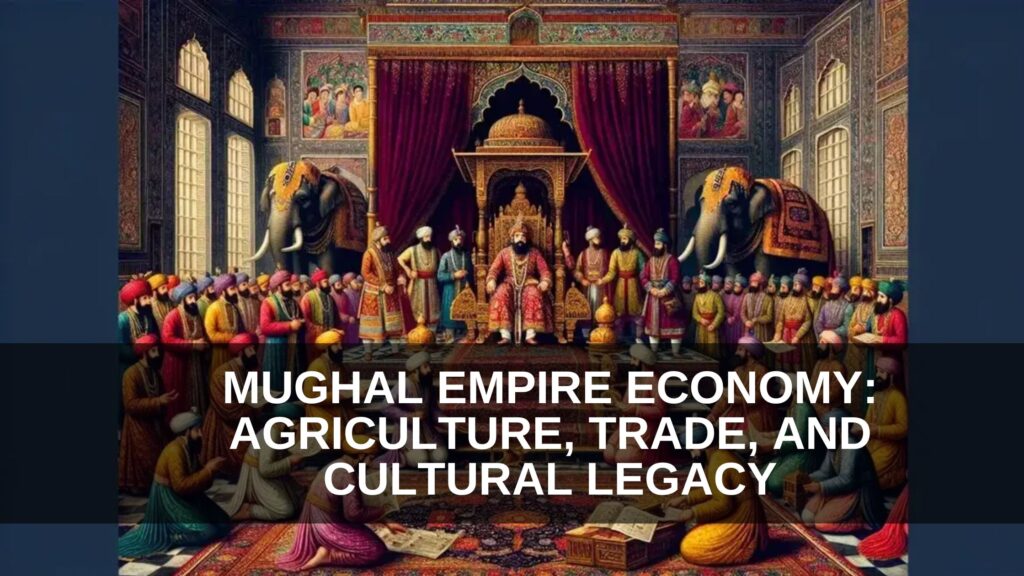The Mughal era was a golden period in India’s history, marked by economic prosperity, agricultural advancements, flourishing trade, and remarkable cultural contributions. By 1700, India accounted for nearly 24% of the world’s GDP, making it the largest economy globally. Let’s take a closer look at the key aspects that defined the Mughal empire economy and its socio-cultural impact.
Agriculture: The Backbone of the Mughal Empire Economy
Agriculture played a crucial role in sustaining the Mughal Empire. Large tracts of land were cultivated, particularly during the reign of Akbar and Aurangzeb. This expansion of farmland significantly boosted the economy and strengthened the empire’s revenue system.
Download notes of The Bhakti Movement in North India
Crops Grown
- Food Grains: Wheat, rice, barley, pulses, and millets like bajra were cultivated extensively.
- Cash Crops: Cotton, sugarcane, oilseeds, and indigo were important crops grown for trade.
- New World Crops: Maize and tobacco, introduced in the 17th century, became widely popular.
- Silk Cultivation: Bengal became a hub for silk production, reducing the need for imports from China.
- Exports: India exported rice and sugar to neighboring countries.
Land Revenue System
- The Mughal administration provided financial assistance (Taccavi) to farmers to enhance agricultural production.
- However, by the late 17th century, heavy taxation led to peasant distress. The tax burden in some regions exceeded 50%, with Zamindars alone taking up to 25% of the total produce.
Mughal Currency: The Silver Standard
The Mughal currency system was well-organized and primarily based on silver.
- Silver Rupaya: Introduced by Sher Shah Suri and continued by Akbar, it remained the primary currency for trade and taxation.
- Gold Ashrafi (Muhr): Used mainly for wealth storage and gifting.
- Copper Dam: The most widely used coin for daily transactions.
- Sea Shells (Kauris): Used in coastal areas for minor exchanges.

Trade and Commerce: A Flourishing Market
Trade flourished under the Mughals, both domestically and internationally.
Key Trade Highlights
- Banjaras: A community of traders specializing in transporting bulk goods over long distances.
- Exports: Bengal exported sugar, rice, fine Muslin, and silk.
- Coromandel Coast: A major hub for textile production, while Lahore became a center for handicrafts.
- Hundis: A financial instrument (letter of credit) used for secure money transfers.
- Merchant Class: The Nagarseth was a leader who represented traders and negotiated with officials.
- Foreign Trade: Gold and silver were imported, strengthening India’s wealth base.
- Political Stability: Law and order facilitated trade expansion during the 17th century.
Mughal Society: A Complex Social Structure
The Mughal social hierarchy was deeply divided, with disparities in wealth and status.
- Peasants and Laborers: The landless peasants (Kamins) were often from the lowest caste and faced severe exploitation.
- Landowners (Khudkasht): Controlled land and exercised power over Kamins but were also under the influence of Zamindars.
- Artisans and Workers: Included soldiers, manual laborers, and craftsmen.
- Mughal Nobility: A privileged class drawn initially from Central Asia and later included Hindu elites under Akbar’s policies.
Mughal Art and Architecture: A Lasting Legacy
Mughal architecture is renowned for its grandeur and elegance, incorporating Persian, Central Asian, and Indian influences.
Architectural Marvels
- Taj Mahal (Agra): Built by Shah Jahan, an epitome of love and artistic brilliance.
- Humayun’s Tomb (Delhi): A precursor to the Taj Mahal, featuring Persian Charbagh-style gardens.
- Red Fort (Delhi): Constructed by Shah Jahan, featuring exquisite Pietra dura designs.
- Fatehpur Sikri: Built by Akbar, featuring Buland Darwaza and Indo-Islamic influences.
- Gardens: Nishat Bagh (Kashmir), Shalimar Bagh (Lahore), and Pinjore Garden (Punjab).
- Mosques: Moti Masjid (Agra), Jama Masjid (Delhi), and Badshahi Mosque (Lahore).
Mughal Art and Music: A Cultural Fusion
Mughal Paintings
Mughal paintings evolved from Persian miniatures and incorporated Hindu, Jain, and Buddhist influences.
- Themes: Battle scenes, royal life, nature, and portraits.
- Akbar’s Karkhana (Workshop): Artists like Daswant and Basawan flourished.
- Jahangir’s Patronage: Portrait painting and natural themes reached their peak.
- Decline Under Aurangzeb: Artists migrated to Rajasthan and Punjab, leading to the rise of regional schools of painting.
Music
- Tansen: The legendary musician under Akbar, composed new ragas.
- Fusion of Hindu and Islamic Styles: Qawwali and Khayal music flourished.
- Aurangzeb’s Ban: Singing was prohibited in his court but continued in noble households.
- Muhammad Shah Rangila: Revived musical traditions and promoted artists.
- Tabla’s Popularity: Became a key instrument in later Mughal times.
Language and Literature: Flourishing Creativity
- Persian Literature: Abul Fazl and Faizi set high literary standards during Akbar’s reign.
- Akbarnama & Ain-i-Akbari: Chronicled Mughal administration and policies.
- Translation of Hindu Texts: The Mahabharata was translated into Persian.
- Regional Literature: Marathi, Bengali, Oriya, and Punjabi gained prominence.
- Tulsidas: The most influential Hindi poet of the era.
- Sanskrit Learning: Banaras remained a major center for scholars.
Religious and Cultural Developments
- Bhakti Movement: Saints like Tukaram and Dadu preached devotion beyond religious barriers.
- Sikhism: Guru Arjun Das compiled the Adi Granth (Granth Sahib).
- Dara Shikoh: Translated the Bhagavad Gita into Persian and sought harmony between Islam and Hinduism.
- Sufism: Continued with the Naqshbandi movement opposing certain mystical beliefs.
Download notes of The Portuguese in India
The Mughal Empire’s Enduring Impact
The Mughal Empire unified India for over a century, fostering economic prosperity, artistic achievements, and cultural synthesis. However, by the mid-18th century, the empire began to decline. Despite this, Mughal art, architecture, and music continued to influence local Indian courts, leaving an indelible mark on the country’s heritage.
Even today, the legacy of the Mughals lives on through their monumental contributions to India’s economy, culture, and artistic brilliance.


